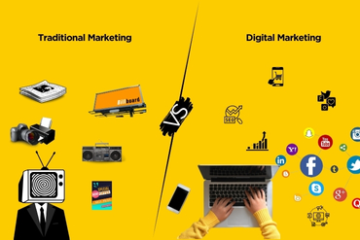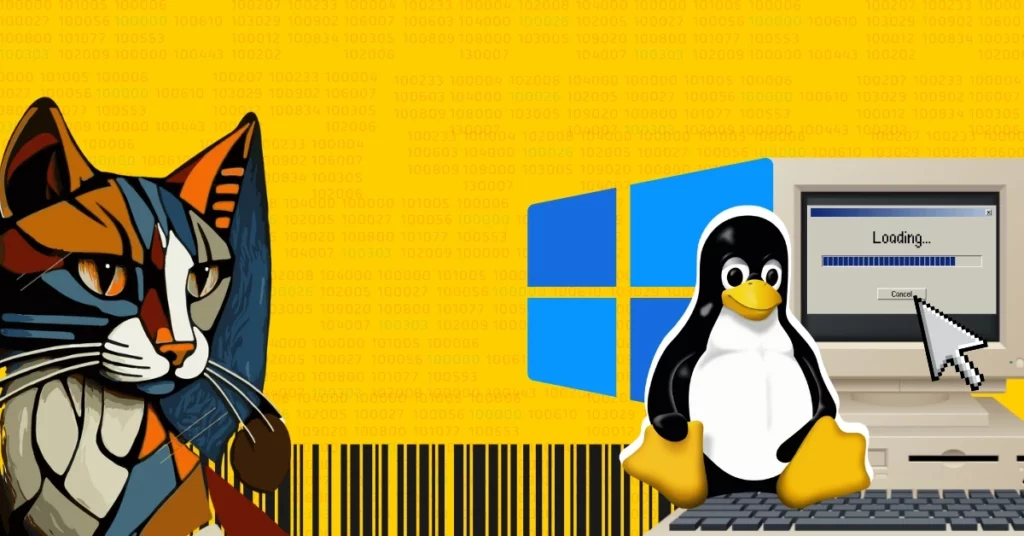
The history and evolution of operating systems are profoundly tangled with the advancement of computing technology, showcasing the ever-changing landscape of human-machine synergy. From the crude batch processing systems of the mid-20th century to the refined multitasking, today’s multi-user environments, operating systems have undergone a salient journey, driven by the implacable diversion of efficiency and user-friendliness.
Table of Contents
Evolution of Operating Systems
This blog aims to check up on the fascinating tale behind the evolution of operating systems,trailing their origins,fundamental milestones, and the transformative innovations that have shaped the way we connect with computers.Grasping the historical context and evolution of operating systems, we can achieve valuable insights into the present state of computing and anticipate future trends in this dynamic field.
The evolution of operating systems can split into several distinct stages, each marked by significant amelioration in technology, computing paradigms, and user interface design. Here’s a comprehensive overview:
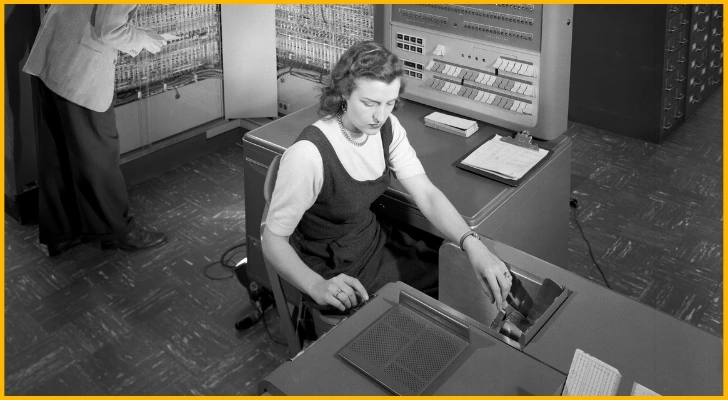
Batch Processing Systems (1950s – 1960s):
- During this era, computers were initially used for batch processing tasks.
- Operating systems like GM-NAA I/O for IBM 704 and Fortran Monitor System (FMS) for IBM 7090 were seasoned prime big.
- The accentuation was on proficient utilization of hardware resources.
Multi-programming Batch Systems (1960s – 1970s):
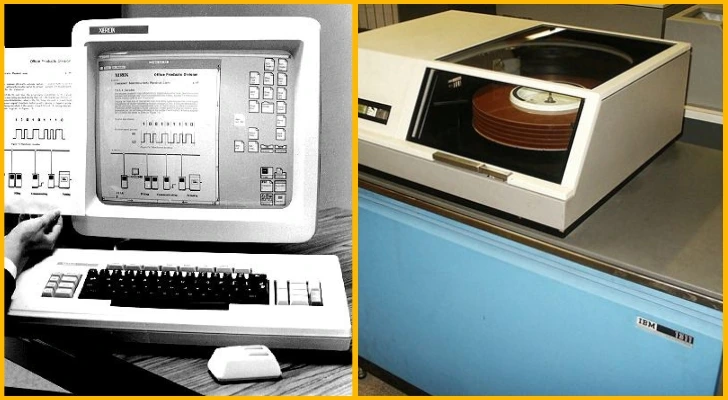
- Introduction of multi-programming, allowing multiple programs to work simultaneously.
- Operating systems like IBM OS/360, CDC SCOPE, and Burroughs MCP were in full bloom aged.
- Time-sharing systems surfaced, permitting multiple users to interact with the computer simultaneously.
Time-sharing Systems (Late 1960s – 1970s):
- Time-sharing allowed multiple users to share the computer’s resources at the same bay.
- Operating systems like CTSS (Compatible Time-Sharing System), MULTICS, and UNIX (a simplified and more portable version of MULTICS) were refined.
- Hierarchical file systems, virtual memory, and process scheduling were introduced.
Personal Computer Operating Systems (1980s):
- The arrival of personal computers led to the development of operating systems bugging individual users.
- MS-DOS (Microsoft Disk Operating System) became vogue on IBM PC and its clones.
- Apple pioneered the Macintosh with its graphical user interface and operating system.
- Commodore Amiga premiered multitasking capabilities with AmigaOS.
Graphical User Interface (GUI) Operating Systems (1980s – 1990s):
- GUI-based operating systems became commanding with the introduction of Windows and MacOS.
- Windows refined from its early versions (Windows 1.0, 2.0) to Windows 3.0, 95, 98, NT, XP, Vista, 7, 8, and 10.
- MacOS morphed from its early versions to MacOS X (now macOS), incorporating attributes like memory protection and proactive multitasking.
Networked Operating Systems (1990s – 2000s):
- The broad uptake of networking technologies led to the far-reaching utilization of networked operating systems.
- UNIX variants like Linux saw a spike in popularity, especially in server environments.
- Windows NT and its successors (Windows 2000, XP, etc.) introduced advanced networking features and security upliftments.
Mobile Operating Systems (2000s – Present):
- The proliferation of smartphones and tablets popularized mobile operating systems.
- Apple’s iOS and Google’s Android became principal entities in the mobile OS market.
- These operating systems debuted touch-based interfaces, app stores, and fine-tuned power management.
Cloud Computing and Virtualization (2000s – Present):
- The ascendance of cloud computing led to the development of operating systems optimized for virtualized environments.
- Operating systems like VMware ESXi, Microsoft Hyper-V, and various Linux distributions tailored for cloud deployment came to the fore.
- Containerization technologies like Docker and Kubernetes also exerted an effect on the evolution of operating systems.
IoT Operating Systems (2010s – Present):
- With the proliferation of Internet of Things (IoT) devices, lightweight operating systems optimized for constrained hardware and low power consumption gained traction.
- Operating systems like FreeRTOS, Zephyr, and mbed OS are widely used in IoT applications.
Hybrid and Future Trends (Present – Future):
- Modern operating systems are unfolding to adapt to hybrid computing environments, including edge computing, hybrid clouds, and AI-driven systems.
- Elements like containerization, microservices architecture, and serverless computing are pioneering the future of operating systems.
The evolution of operating systems has been a dynamic journey, spanning decades of innovation and adaptation. From the early days of simple batch processing systems to the sophisticated multitasking and virtualization capabilities of modern OSes, the trajectory of their development mirrors the rapid pace of technological advancement. With each iteration, operating systems have evolved to accommodate diverse computing needs, from personal computers to massive server clusters, from embedded devices to cloud-based infrastructures.
As the demands on computing environments continue to evolve, so too does the evolution of operating systems, perpetually shaping the landscape of digital ecosystems. Whether it’s the seamless integration of IoT devices or the orchestration of distributed computing resources, the evolution of operating systems remains a cornerstone of technological progress, continually refining the foundations of our digital world.
Evolution of the Windows Operating System
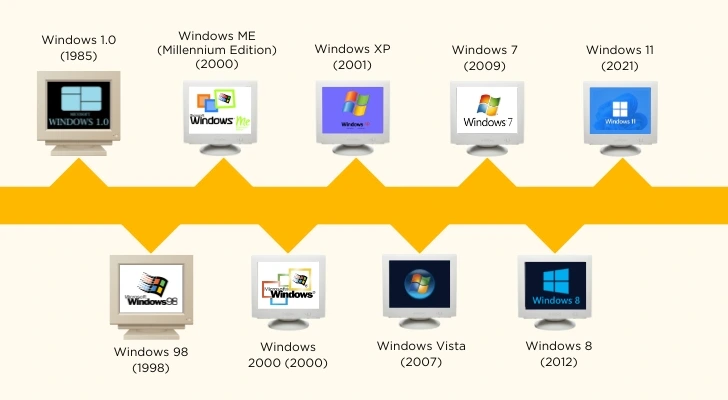
The evolution of the Windows operating system spans several decades, marked by significant advancements in technology and user experience. Here’s a brief overview:
- Windows 1.0 (1985): Introduced as a graphical user interface shell for MS-DOS, Windows 1.0 featured a simple interface with tiled windows and limited multitasking capabilities.
- Windows 2.0 (1987): Improved performance and introduced overlapping windows, desktop icons, and expanded application support.
- Windows 3.0 (1990): A major release that brought significant improvements in performance, multimedia support, and enhanced user interface elements like Program Manager and File Manager.
- Windows 95 (1995): A milestone release that introduced the iconic Start menu, taskbar, and support for 32-bit applications. Windows 95 also brought Plug and Play capabilities and significant improvements in networking.
- Windows 98 (1998): Built upon the success of Windows 95, Windows 98 offered improved performance, enhanced hardware support, and introduced features like Windows Update.
- Windows ME (Millennium Edition) (2000): Targeted towards home users, Windows ME aimed to improve multimedia capabilities and introduced features like System Restore but faced criticism for stability issues.
- Windows 2000 (2000): Designed for business environments, Windows 2000 merged the consumer and business lines, offering improved stability, security, and support for newer hardware.
- Windows XP (2001): One of the most successful versions of Windows, XP brought a redesigned interface, improved networking, and multimedia features. It remained popular for many years.
- Windows Vista (2007): Introduced a visually revamped interface with Aero glass, enhanced security features, and improved search functionality, but faced criticism for performance issues and compatibility.
- Windows 7 (2009): Regarded as a highly successful release, Windows 7 addressed many of the criticisms of Vista, offering improved performance, stability, and user interface refinements.
- Windows 8 (2012): Introduced a touch-optimized interface with Live Tiles, aiming for convergence between desktop and mobile platforms, but received mixed reviews, particularly from traditional desktop users.
- Windows 8.1 (2013): An update to Windows 8, bringing back some traditional desktop features and addressing user feedback.
- Windows 10 (2015): A significant shift towards a service-based model with continuous updates, Windows 10 aimed to unify the user experience across various devices, including PCs, tablets, and smartphones.
- Windows 11 (2021): Introduced with a redesigned user interface, centered around productivity, gaming, and a more seamless integration with the cloud, while also focusing on security enhancements and better performance.
Each version of Windows brought new features, improved performance, and advancements in technology, shaping the landscape of personal computing over the years.
Evolution of the Linux Operating System
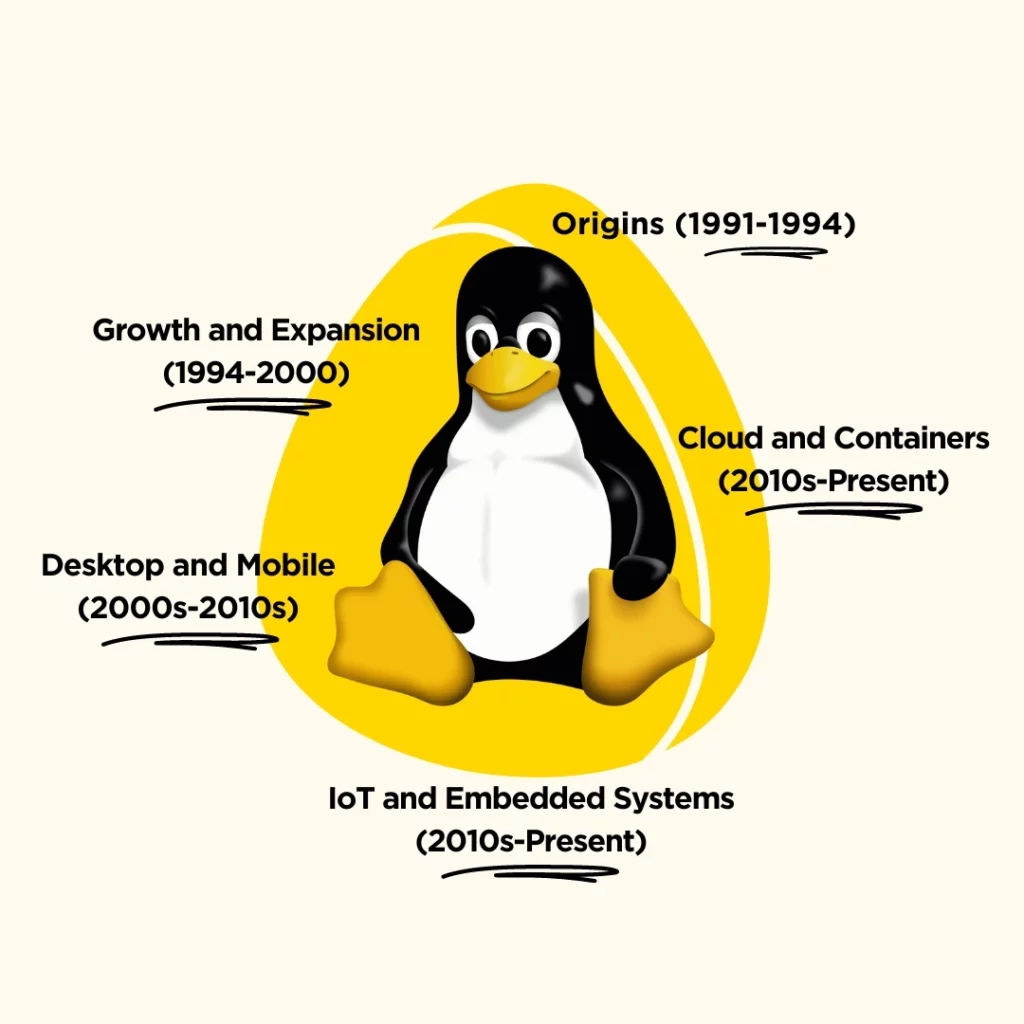
The evolution of the Linux operating system has been an intriguing voyage, marked by significant milestones, technological advancements, and community-driven development. Here’s an overview of its evolution:
- Origins (1991-1994): Linux was created by Linus Torvalds in 1991 as a leisure pursuit while he was a student at the University of Helsinki. He released the first version of the Linux kernel (version 0.01) in September 1991. Initially, it was just a kernel without many of the tools and attributes commonly associated with operating systems.
- Growth and Expansion (1994-2000): During this period, Linux built traction as developers around the world began contributing to its development. The GNU project’s utilities and the X Window System were integrated with the Linux kernel,creating a wholesome operating system. Distributions such as Slackware, Debian, and Red Hat emerged, making Linux more accessible to users.
- Enterprise Adoption (2000s): Linux started gaining traction in the enterprise sector, particularly in server environments. Companies like IBM, Oracle, and HP began offering support for Linux, boosting its credibility and adoption in corporate environments. The stability, security, and cost-effectiveness of Linux forge it a tempting preference for businesses.
- Desktop and Mobile (2000s-2010s): While Linux had been principally used in server environments, efforts were crafted to refine its usability on desktops and even mobile devices. Projects like GNOME and KDE offered user-friendly desktop environments, and distributions like Ubuntu obtained popularity for their ease of use. Android, based on the Linux kernel, positioned itself as a key player in the mobile operating system market.
- Cloud and Containers (2010s-Present): Linux has become the dominant operating system in cloud computing and containerized environments. Technologies like Docker and Kubernetes rely heavily on Linux for their operation. Major cloud providers such as Amazon Web Services, Google Cloud Platform, and Microsoft Azure offer Linux-based virtual machines and container services.
- IoT and Embedded Systems (2010s-Present): Linux has also found widespread adoption in the Internet of Things (IoT) and embedded systems as a result of its adaptive capabilities, growth potential, and community-driven model.Individualized distributions for IoT applications have emerged, energizing diverse devices, from smart appliances to industrial machinery.
- Advancements in Security and Performance: Over the years, Linux has seen significant improvements in terms of security features, performance optimizations, and support for modern hardware architectures. Features like SELinux, AppArmor, and system have enhanced security and management capabilities.
- Community Development Model: Central to Linux’s evolution is its community-driven development model. Thousands of developers worldwide contribute to the Linux kernel and associated projects, ensuring rapid innovation and continuous improvement.
Overall, the evolution of operating systems like the Linux has been characterized by its adaptability, versatility, and resilience, making it one of the most widely used and influential operating systems in the world.
Conclusion
In conclusion, exploring the history and evolution of operating systems unveils a captivating odyssey from the rudimentary management of hardware resources to the advanced, feature-rich environments we navigate today. From the pioneering efforts of early systems like UNIVAC I and UNIX to the widespread adoption of GUI-based interfaces in personal computing, operating systems have continually adapted to meet the evolving needs of users and technology.
As we look to the future, trends in mobile dominance, security enhancements, and the proliferation of lightweight and specialized operating systems for diverse devices promise to shape the landscape of computing even further. Understanding this journey not only provides insight into the foundations of modern computing but also underscores the ongoing innovation driving the development of operating systems worldwide.
FAQs
What was the first operating system?

This question often comes up when discussing the history of operating systems. The answer typically points to several contenders depending on the criteria used. Some cite GM-NAA I/O, developed by General Motors in the late 1950s, while others argue for the Manchester Baby’s “Manchester Autocode” from 1948. However, many recognize the General Motors OS (1956) or the UNIVAC I operating system (1951) as some of the earliest examples.
How did early operating systems differ from modern ones?
Early systems were simple, managing hardware resources, while modern ones offer multitasking, GUIs, and extensive networking.
What role did UNIX play in OS development?
UNIX has had a profound impact on the evolution of operating systems. Developed in the late 1960s and 1970s at Bell Labs, UNIX introduced many concepts that are still fundamental in modern operating systems, such as hierarchical file systems, the shell as a command-line interface, and the idea of modular software components. Additionally, UNIX inspired the development of many other operating systems, including Linux and macOS.
How did personal computing impact OS development?
MS-DOS and Windows (1980s) and macOS popularized GUIs, making computing accessible. Mobile OSs like Android and iOS emerged.
What are recent trends in OS development?
Trends include mobile OS dominance, emphasis on security/privacy, containerization for cloud computing, and lightweight OSs for IoT devices.



